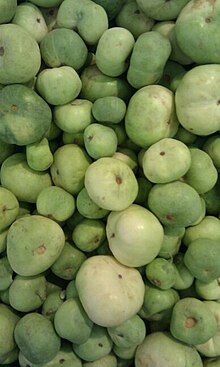| This article needs additional citations for verification. Please help improve this article by adding citations to reliable sources. Unsourced material may be challenged and removed. Find sources: "Tinda" – news · newspapers · books · scholar · JSTOR (October 2019) (Learn how and when to remove this message) |
| Tinda | |
|---|---|

| |
| Scientific classification | |
| Kingdom: | Plantae |
| Clade: | Tracheophytes |
| Clade: | Angiosperms |
| Clade: | Eudicots |
| Clade: | Rosids |
| Order: | Cucurbitales |
| Family: | Cucurbitaceae |
| Genus: | Benincasa |
| Species: | B. fistulosa |
| Binomial name | |
| Benincasa fistulosa (Stocks) H.Schaef. & S.S.Renner (2011) | |
| Synonyms | |
| |
Benincasa fistulosa, commonly known as tinda, also called Indian squash, round melon, Indian round gourd, apple gourd or Indian baby pumpkin, is a squash-like cucurbit grown for its immature fruit, a vegetable especially popular in South Asia.
Description and use in cooking
The plant is as with all cucurbits, a prolific vine, and is grown as an annual. The plant also is prickly with small thorns similar to the zucchini. The fruit is approximately spherical, and 5–8 cm in diameter The seeds may also be roasted and eaten. Tinda is a famous nickname among Punjabi families in both India and Pakistan.
This unique squash-like gourd is native to India, very popular in Indian and Pakistani cooking with curry and many gourmet dishes. Green colored, apple-sized fruits are flattish round in shape and 50–60 grams in weight. Plants are vigorous, productive and begin to bear fruits in 70 days after planting.
Variant names
Tinda is also called aibhi (ऐभी) or "हस्तिघोषालताफलम्" (elephant's nest fruit) in Sanskrit . It is called tindsi in Rajasthan, and in Marathi it is called dhemase (ढेमसे). In Hindi and Marathi it is called dilpasand, and in Sindhi it is called meha (Sindhi: ميها).
Similarly-named plants
Tinda can be confused with tendli or kundru due to similar-sounding names from different languages and regions. In Punjabi, Hindi, and most other North Indian languages, the word tinda means "Indian baby pumpkin."
Production
Global production of the tinda fruit was estimated to be about 1.3 million metric tons in 2013. India is the largest producer of tinda, followed by Pakistan and Bangladesh. Other major producing countries include China, Nepal, and Sri Lanka.
References
- Benincasa fistulosa (Stocks) H.Schaef. & S.S.Renner. Plants of the World Online. Retrieved 10 June 2024.
- "Newly Notified Varieties of Seeds". Seednet.gov.in. Archived from the original on April 27, 2017. Retrieved March 4, 2017.
- "शब्दकल्पद्रुमः/ए - विकिस्रोतः". sa.wikisource.org (in Sanskrit). Archived from the original on 2021-10-22. Retrieved 2021-10-22.
- "Tinda fruit global production". husfarm.com.
External links
| Taxon identifiers | |
|---|---|
| Benincasa fistulosa | |
| Praecitrullus fistulosus | |
| Citrullus fistulosus | |
This vegetable-related article is a stub. You can help Misplaced Pages by expanding it. |